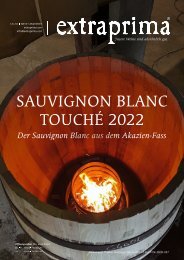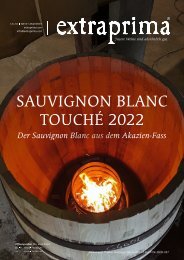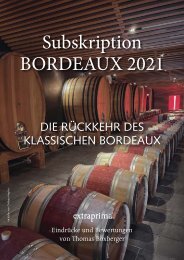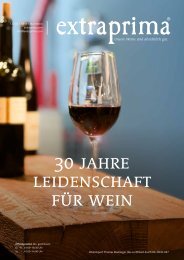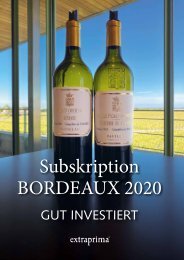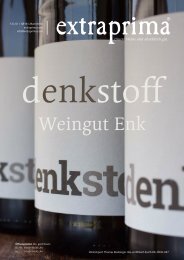Create successful ePaper yourself
Turn your PDF publications into a flip-book with our unique Google optimized e-Paper software.
<strong>Bordeaux</strong><strong>2018</strong><br />
extraprima<br />
6<br />
later on July 15 in <strong>Bordeaux</strong> and southern Gironde. Further, about<br />
10,000 hectares again were affected by frost in <strong>2018</strong>, which is around<br />
8% of the vineyards. As in the previous months, precipitation varied<br />
widely, from 40 mm in the northern Médoc to almost 100 mm<br />
in Sauternes, at an average temperature in July <strong>2018</strong> being the highest<br />
since 1954.<br />
The warm, humid weather and strong vegetation helped the<br />
mildew grow incredibly. Fortunately, the weather changed radically<br />
in mid-July, leading to a warm and dry summer. This also slowed<br />
down the growth and ripening of the grapes. The daily maximum<br />
and minimum temperatures were between 0.5° and 3° C above<br />
average, without reaching the record levels of 2003. The change of<br />
color (Véraison) of the berries began at the end of July. Apart from<br />
some vineyards affected by hailstorms, the Véraison was completed<br />
quickly and uniformly in an almost regular time schedule. At this<br />
stage of the growing process, for a great vintage, the vines need a<br />
water shortage from precipitation as a signal to stop its vegetative<br />
growth and move its power into the maturation of the grapes. In<br />
terroirs with good drainage, this process began earlier; for the rest<br />
in mid-August, the water supply was down to comparable levels as<br />
in 2016. Now the ripening process of the grapes began in dry and<br />
hot conditions. Due to the water reserves in the deeper soils, the<br />
dryness was initially less problematic. Smaller showers at the end<br />
of August relaxed the water shortage, only some young vines on<br />
water-permeable, dry soils have been in difficulties. A dry September<br />
brought temperatures of 2 to 4 ° C above average, and it was<br />
one of the sunniest September of the last 60 years. As a result, the<br />
ripening process slowed uniformly, which allowed growers to wait<br />
for the best harvesting time for each grape variety and microclimate,<br />
without any risk of putrefaction.<br />
WHITE WINES<br />
With picking the Sauvignons from the last week of August, the<br />
harvest of the white grapes was beginning about one week later<br />
than the previous year. Sémillons have been harvested until<br />
mid-September. The damp spring prevented acidity levels dropping<br />
down significantly due to the dryness in the summer, as the subsoils<br />
still had good water reserves. Nevertheless, acidities have been<br />
lower for white wines than in 2017, with generally higher sugar<br />
levels. <strong>2018</strong>s Sauvignon Blancs aromatically have been significantly<br />
more expressive than the less tastily Sémillons. Therefore in most<br />
assemblages, the Sauvignon Blanc dominates the Sémillon clearly.<br />
For the white Haut-Brion <strong>2018</strong> is one of the best vintages of the past<br />
20 years. Instead of the usual assemblage of 50 % each, Sauvignon<br />
blanc and Semillon, <strong>2018</strong> vintage consists of 80 % Sauvignon blanc,<br />
actually tasting like a single variety. A lot of <strong>2018</strong>s white wines are<br />
exciting, especially the white <strong>Bordeaux</strong> from the Médoc!<br />
RED WINES<br />
Already at the beginning of the harvest for the red varieties, on<br />
around the 7 th of September, sugar levels in the early ripening Merlots<br />
have been quite high. Low acidity levels were due to the low<br />
content of malic acid in relation to tartaric acid. The aromatic expressiveness<br />
of the grapes grew in mid-September, the grape skins<br />
were thick and porous, with a high content of anthocyanins, which<br />
resulted in a rapid color extraction. The extremely ripe grape seeds<br />
led to especially rounded musts, without any green aromas. Directly<br />
after fermentation, the <strong>2018</strong> Merlots showed a higher quality<br />
level than in 2016 and 2017, with an unusual dark fruit component.<br />
The typical red berry aroma of this grape variety was often missing<br />
entirely. The ideal weather conditions of September lasted until<br />
mid-October, benefitting the late-maturing Cabernets and the Petit<br />
Verdot. Finally, Cabernet Francs did not show any herbaceous or<br />
immature notes, and the Cabernet Sauvignons developed a pronounced<br />
cassis fruit with a full-bodied structure. Also, Petit Verdot<br />
was reaching full ripeness with a powerful, dark scented elderberry<br />
aroma, which is present in the back aromas of many wines. Even<br />
these later ripening varieties had extremely ripe grape seeds. The<br />
long and consistent Indian summer in <strong>2018</strong> provided a perfect harvesting<br />
period without any risk of putrefaction or haste during the<br />
harvest. Each parcel and grape variety for dry white and red wines<br />
had been able to be picked under ideal conditions. In order to<br />
prevent negative influences on the musts, occasionally dried and<br />
shrunken grapes had to be selected at the sorting tables as well as<br />
the berries affected by mildew. Mostly a gentler extraction of the<br />
skins was operated for the vinification of red wines, with less remontage<br />
and pigeage than usual (the overshoot or submergence of<br />
the pomace). Even the fermentation temperature mostly was chosen<br />
to be slightly cooler with a maximum of 28° C. After the alcoholic<br />
fermentation, the musts often remained without further extraction<br />
of the grape skins, more in the sense of the preparation of<br />
a tea. <strong>Bordeaux</strong>’ <strong>2018</strong> reds are very powerful, dark-berried wines<br />
with an incredible presence on the palate. Amazingly in this vintage,<br />
the grape varieties Merlot, Cabernet Franc, and Cabernet Sauvignon<br />
are not very different in flavor, especially because the Merlot<br />
has changed its red fruity aromatic for dark-berried massiveness.<br />
In many wines, the Petit Verdot gives a special spiciness and profundity<br />
to the finish.<br />
SWEET WINES<br />
Although summer rainfalls have been a bit more in the Sauternes<br />
area than in other regions of <strong>Bordeaux</strong>, the dry and warm conditions<br />
of September and October delayed the spread of noble rot<br />
Botrytis cinerea. Early ripening grapes even shrank to rosinated<br />
berries (passerillage). At the first trie of the harvest, such grapes<br />
had to be sorted out immediately. From the second week of October<br />
with cool nights and higher humidity, botrytis has spread<br />
quickly over the vineyards enhanced by some north winds. The<br />
second trie now was bringing the largest yield of the vintage. By a<br />
rainy period in mid-October, another botrytis wave occurred. The<br />
last trie took place from late October to early November. Acidity<br />
levels were quite low due to the warm summer, but concentration<br />
was high. Thus, the sweet wines of the vintage <strong>2018</strong> show ripe<br />
aromas with a full-bodied structure, but they don’t show the tension<br />
and depth of a truly great vintage.<br />
Text by Thomas Boxberger © 2019





